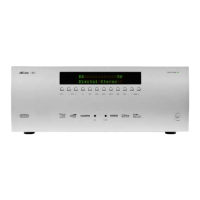15
The DSPs’ programs are stored in two external 3V3 SPI ash memory chips – IC106 (8Mbit) for IC141 and
IC107 (4Mbit) for IC142.
IC141 has two sets of I2S data inputs. DAI (pins 23, 24, 26, 27 for data, pin 29 for the system clock and pin
30 for the LR clock) is for up to 8 channels from the HDMI Board via connector WF104.
DA2 (pins 32 for the LR clock, 33 for system clock and 34 for data) is for audio from the codec IC143. This
includes bitstream SPDIF such as Dolby Digital, uncompressed two channel I2S audio decoded from
SPDIF and ADC generated I2S two channel audio.
The DSP master clock is input on pin 40 of IC141 from pin 9 of IC145 as noted earlier.
IC141 also has two sets of I2S data outputs. DA1 is an 8 channel I2S signal (pins 47, 48, 49 and 51) shown
as part of the bus DA0(04:07). This feeds the input of the second DSP IC142 (on pins 23, 24, 26 and 27).
The system clock is on pin 52 of IC141 and the LR clock on pin 54. These go to pins 29 and 30 of IC142.
DA2 is a stereo I2S output (pin 43 for data, pin 44 for the system clock and pin 46 for the LR clock). This
feeds the HDMI board via WF104 and the octal bus switch IC146. The DSP master clock output from
pin 9 of IC145 follows the same route. An SPDIF output from pin 35 of IC141 goes directly to pin 12 of
WF104.
There is one set of 8 channel I2S outputs from IC142 – DA1 (pins 47, 48, 49 and 51). These form part of
the data bus DA0(00:03) where they are routed back to the DACs in IC143 (pins 62, 64, 63 and1 respec-
tively). The I2S system clock and LR clock (pins 52 and 54) also go directly to IC143 (pins 2 and 3).
System Control Microprocessors
There are 3 microprocessors on the Input Board, the main, the sub and the USB micro. The latter is also
kept separate in order to perform upgrades over USB.
The AVR360’s main system microprocessor IC151 is a Toshiba T5CN5 microcontroller. This has an ARM
Cortex 3 core with 512KB of ROM and 32KB of ash memory. It is a 3V3 part, with this power supply
being derived from the main 5V supply via the 3-terminal regulator IC156. It has a 40MHz system clock
derived from crystal X702 and a real time clock from the 32.768 kHz crystal X708.
IC152 is a 32Kbit EEPROM for retaining system settings at power down.
IC155 is a MOSFET switch to enable the HDMI CEC (Consumer Electronic Control) bus when the unit is
powered up, and to isolate the parts of the bus external to the AVR360 when it is powered down.
IC151 has several sets of comms busses - SPI, I2C and UARTs - depending on which system or peripheral
ICs are being addressed. SPI (Serial Peripheral Interface) is a fast 3-wire interface (clock, transmit and
receive) with chip select being addressed by individual I/Os. I2C (Inter Integrated Circuit) is a relatively
slow bidirectional 2-wire interface, with open-collector/source clock and transmit/receive busses, each
with a pull up resistor, and a limited number of embedded chip addresses. UART stands for Universal
Asynchronous Receiver/Transmitter and is a form of bus that takes bytes of information and turns them
into serial data on a bus before reassembling them into bytes at the other end.
SPI is used to talk to the codec IC143 and the two DSPs IC141 and IC142.
I2C is used for both the main and zone 2 volume controls IC101 and IC131. I2C also connects to the sub
micro IC154 and to the NJW1321 video input decoders IC81 and IC81.
IC151’s UARTs are used for USB Tx/Rx, the Torino (video processor) Tx/Rx and the external RS232 Tx/Rx.

